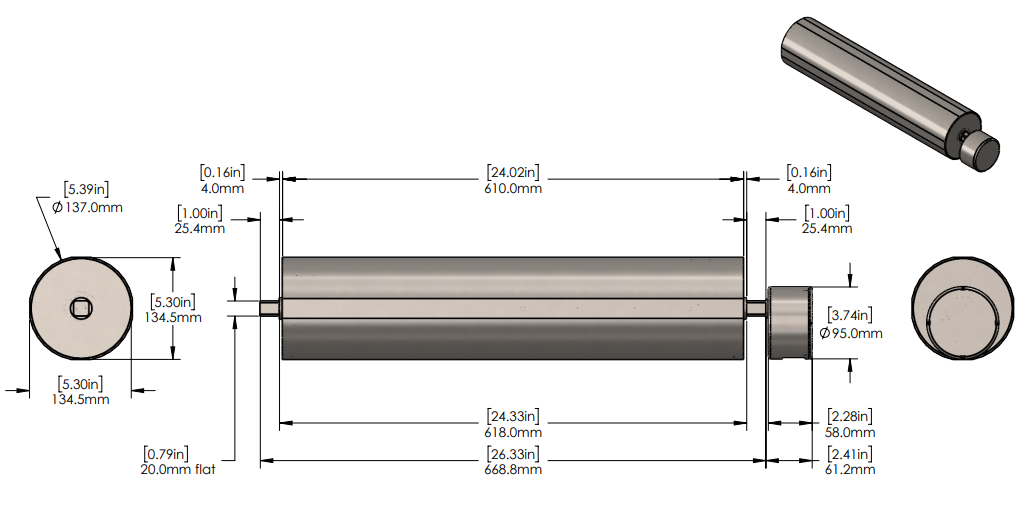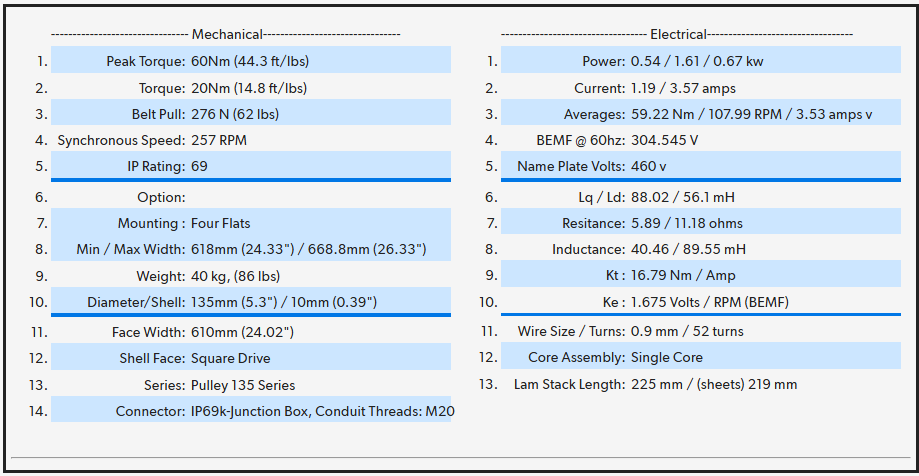Download Tuning Guide
One Motion Tuning Example / Best Practices
1. Overview
One Motion Products are designed for tough washdown sanitary environments (IP69K-rated), like food processing plants handling meat, cheese, or baked goods. Mag-Drives are built for reliability, require zero maintenance under normal conditions, and come with a 3-year warranty. They’re rated to last longer than all other solutions on the market.
This guide helps your maintenance team manage current levels during setup and troubleshooting to keep the Mag-Drives running efficiently.
Example Product:
This is a relative guide based on example part
(OD69-60-135-610-11193).
Each One Motion product has its own technical data specs.
Contact Technical Support for your PN technical data information.

We’ll use an example Mag-Drive with these ratings (found on its One Motion product data sheet example):

Example Current Values
- Continuous Current: 1.19 A
- Maximum Current: 3.57 A
⚠️ Important: Continuous and max current values are product-specific. Always check the One Motion product data sheet for your Mag-Drive’s exact ratings before setup or troubleshooting.
2. What Are Current Limits?
Current limits tell you how much electrical current your Mag-Drive can handle safely. Going over these limits can overheat the Mag-Drive, causing damage or early failure. Here’s what they mean:
Continuous Current
This is the normal operating current for steady, continuous use. For our example Mag-Drive, it’s 1.19 A (check your product data sheet for your Mag-Drive’s value).
✅ Stay Safe: Run the Mag-Drive at or below 1.0–1.1 A to keep it cool and extend its life.
Maximum Current
This is the highest current the Mag-Drive can handle during short bursts, like startup or sudden heavy loads. For our example Mag-Drive, it’s 3.57 A (again, check your product data sheet).
⚠️ Limit Time: Don’t let the Mag-Drive run near max current for more than 20% of its duty cycle.
e.g. For a 10-minute cycle (600 seconds), that’s 120 seconds max. For a 5-minute cycle (300 seconds), it’s 60 seconds max.
3. Best Practices for Use (PowerFlex 525 as Example)
In a washdown environment, Mag-Drives face wet conditions, high-pressure cleaning, and potential load spikes from slippery surfaces or product surges. Follow these best practices to keep your One Motion Mag-Drive safe and running well:
| Best Practice |
Target |
Why It Matters |
| Keep continuous current below 1/3 of max |
≤ 1.19 A (check your data sheet) |
Stops the Mag-Drive from overheating during long runs |
| Run in the safe range |
1.0–1.1 A |
Gives a safety buffer to prevent damage |
| Limit max current time |
≤ 20% of duty cycle (e.g., 120 sec in 10 min) |
Prevents heat buildup and stress during startups or surges |
| Check current often |
Use drive’s B003 parameter |
Lets you spot problems early and adjust |
4. How to Set Up Your PowerFlex 525 Drive
The Allen-Bradley PowerFlex 525 drive helps control and protect your Mag-Drive. Use Connected Components Workbench (CCW) software to set it up with the following settings, updated to align with your Mag-Drive’s needs in a washdown environment:
Step 1: Enter Mag-Drive Data
Use the values from your One Motion product data sheet to set these parameters:
| Parameter |
Setting |
What It Does |
| P033 | 60 Hz | Sets the Mag-Drive’s frequency |
| P034 | 1.19 A (use your data sheet value) | Sets the continuous current |
| P036 | 257 RPM | Sets the Mag-Drive’s speed |
| P484/485 | 3.22 A | Sets a safe overcurrent limit |
Step 2: Set Up Safety Protections
These settings stop the Mag-Drive from running too hot or overloading:
| Parameter |
Setting |
What It Does |
| A484 | 4.00 A | Set drive fault limit (absolute limit) |
| A486 | 2.38 A (1.19 × 2.0) | First overcurrent warning level |
| A487 | 10 sec | Waits 10 sec before stopping if overcurrent |
| A488 | 3.57 A (use your max current) | Final overcurrent limit |
| A489 | 5 sec | Stops if max current lasts over 5 sec |
Step 3: Adjust Start and Stop Settings
These settings help avoid big current spikes when starting or stopping:
| Parameter |
Setting |
What It Does |
| P041 | 10 sec | Mag-Drive speed to target Hz (application specific) |
| P042 | 10 sec | Mag-Drive speed to 0 Hz (application specific) |
5. Troubleshooting in a Washdown Environment
Here’s how to handle common issues in a washdown sanitary environment, like after cleaning or during heavy loads, using the updated settings:
Scenario A: Normal Operation (Cheese Block Conveyor)
Situation: Conveyor moving cheese blocks (2 kg each) for packaging, running 8 hours a day.
Goal: Keep current at 1.0–1.1 A.
Steps:
- Check B003 on the drive to see live current (should be 1.0–1.1 A).
- If current goes over 1.19 A (e.g., from cheese residue buildup), clean the conveyor to reduce friction.
- Drive will stop if current stays above 2.38 A for 10 sec (A486/A487 settings).
Scenario B: Restart After Washdown (Wet Trays)
Situation: Conveyor restarts after a high-pressure washdown, moving wet trays of chicken.
Goal: Avoid max current (3.57 A) for more than 60 sec in a 5-min cycle.
Steps:
- Soft start (P041 at 10 sec) keeps startup current around 2.5 A.
- If current hits 3.57 A (e.g., trays stick due to suction), drive stops after 5 sec (A489 setting).
- After startup, ensure current settles to 1.0–1.1 A; dry trays if needed to reduce sticking.
Scenario C: Heavy Load Surge (Meat Packages)
Situation: Sudden surge of heavy meat packages (3 kg each) on the conveyor.
Goal: Limit max current (3.57 A) to under 120 sec in a 10-min cycle.
Steps:
- Drive stops if current hits 3.57 A for over 5 sec (A489 setting).
- If the conveyor slips, increase A533 (suggest 1 Hz increment) to improve grip.
- If speed stutters, increase A581 (suggest +2) to smooth it out.
- Spread out the packages to lower the current back to 1.0–1.1 A.
6. Quick Reference Summary
| Operation Type |
Safe Limit |
Drive Settings to Check |
| Normal Running |
1.0–1.1 A (max 1.19 A) |
B003, A484 |
| Startup or Surge |
≤ 3.57 A for ≤ 20% of cycle |
A488/A489, P041 |
| Safety Protections |
Stop if over limits |
A486/A487, A488/A489 |
7. Request PN Technical Data:
Contact Technical Support for your specific part number's technical data information.



